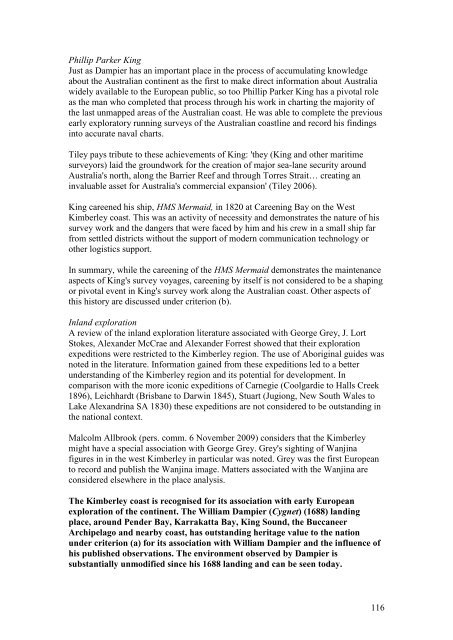WEST KIMBERLEY PLACE REPORT - Department of Sustainability ...
WEST KIMBERLEY PLACE REPORT - Department of Sustainability ...
WEST KIMBERLEY PLACE REPORT - Department of Sustainability ...
Create successful ePaper yourself
Turn your PDF publications into a flip-book with our unique Google optimized e-Paper software.
Phillip Parker King<br />
Just as Dampier has an important place in the process <strong>of</strong> accumulating knowledge<br />
about the Australian continent as the first to make direct information about Australia<br />
widely available to the European public, so too Phillip Parker King has a pivotal role<br />
as the man who completed that process through his work in charting the majority <strong>of</strong><br />
the last unmapped areas <strong>of</strong> the Australian coast. He was able to complete the previous<br />
early exploratory running surveys <strong>of</strong> the Australian coastline and record his findings<br />
into accurate naval charts.<br />
Tiley pays tribute to these achievements <strong>of</strong> King: 'they (King and other maritime<br />
surveyors) laid the groundwork for the creation <strong>of</strong> major sea-lane security around<br />
Australia's north, along the Barrier Reef and through Torres Strait… creating an<br />
invaluable asset for Australia's commercial expansion' (Tiley 2006).<br />
King careened his ship, HMS Mermaid, in 1820 at Careening Bay on the West<br />
Kimberley coast. This was an activity <strong>of</strong> necessity and demonstrates the nature <strong>of</strong> his<br />
survey work and the dangers that were faced by him and his crew in a small ship far<br />
from settled districts without the support <strong>of</strong> modern communication technology or<br />
other logistics support.<br />
In summary, while the careening <strong>of</strong> the HMS Mermaid demonstrates the maintenance<br />
aspects <strong>of</strong> King's survey voyages, careening by itself is not considered to be a shaping<br />
or pivotal event in King's survey work along the Australian coast. Other aspects <strong>of</strong><br />
this history are discussed under criterion (b).<br />
Inland exploration<br />
A review <strong>of</strong> the inland exploration literature associated with George Grey, J. Lort<br />
Stokes, Alexander McCrae and Alexander Forrest showed that their exploration<br />
expeditions were restricted to the Kimberley region. The use <strong>of</strong> Aboriginal guides was<br />
noted in the literature. Information gained from these expeditions led to a better<br />
understanding <strong>of</strong> the Kimberley region and its potential for development. In<br />
comparison with the more iconic expeditions <strong>of</strong> Carnegie (Coolgardie to Halls Creek<br />
1896), Leichhardt (Brisbane to Darwin 1845), Stuart (Jugiong, New South Wales to<br />
Lake Alexandrina SA 1830) these expeditions are not considered to be outstanding in<br />
the national context.<br />
Malcolm Allbrook (pers. comm. 6 November 2009) considers that the Kimberley<br />
might have a special association with George Grey. Grey's sighting <strong>of</strong> Wanjina<br />
figures in in the west Kimberley in particular was noted. Grey was the first European<br />
to record and publish the Wanjina image. Matters associated with the Wanjina are<br />
considered elsewhere in the place analysis.<br />
The Kimberley coast is recognised for its association with early European<br />
exploration <strong>of</strong> the continent. The William Dampier (Cygnet) (1688) landing<br />
place, around Pender Bay, Karrakatta Bay, King Sound, the Buccaneer<br />
Archipelago and nearby coast, has outstanding heritage value to the nation<br />
under criterion (a) for its association with William Dampier and the influence <strong>of</strong><br />
his published observations. The environment observed by Dampier is<br />
substantially unmodified since his 1688 landing and can be seen today.<br />
116
















